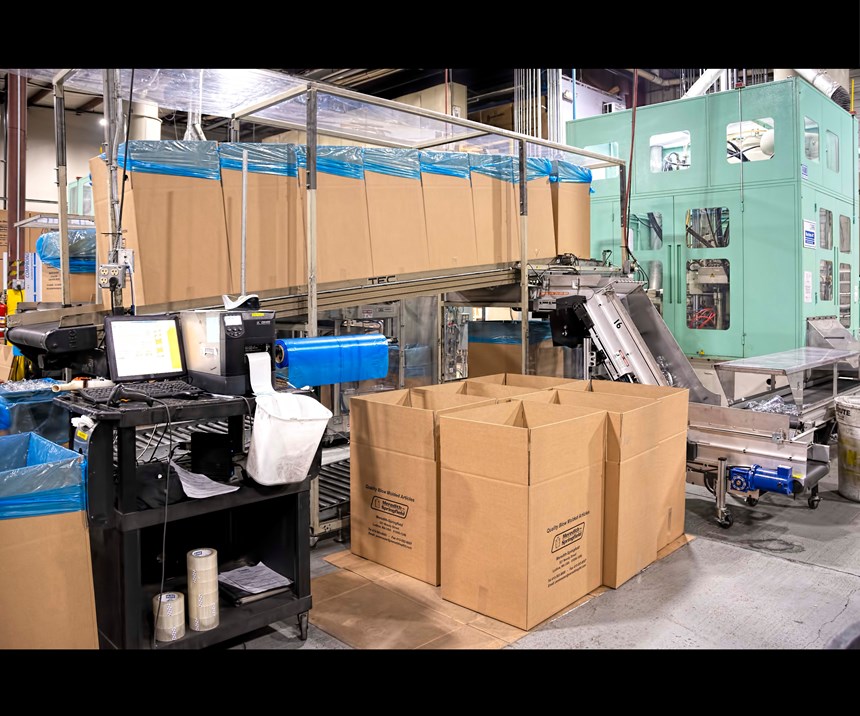Are We Having a Good Day? Real-Time Production Data Has Answers for a Custom Blow Molder
“Information automation” is one of the keys to running a successful custom blow molding business for Meredith-Springfield Associates.
“We use automation as much as possible,” says Mel O’Leary, president, CEO and co-founder of custom blow molder Meredith Springfield Associates (MSA) in Ludlow, Mass. He points to an automated box filler that indexes empty boxes into position below the end of the conveyor taking finished bottles from a blow molder. The box is shaken gently and continuously to settle the bottles as they drop in. When the box is full—determined by weight—it travels to the other end of the box filler, where an employee will attach a barcoded label and scan the label into the central plant computer. “With this auto packer, one person can tend four machines,” notes O’Leary.
But mechanical automation is not the only—or the most important—kind of automation in the plant. “We depend highly on information automation,” explains O’Leary. “Competitors can’t believe what we’re doing with information systems.”
Since 2002, MSA has used an enterprise ERP system from CyFrame that handles accounting, bills of lading, invoices, accounts receivable, general ledger, and even printing of packing slips. O’Leary says, “We were the beta site for their blow molding solution. It allows us to have only three administrative people—a small number for a company this size (100 employees, over $15 million annual revenue), and fewer than we had 18 years ago. We used to rely on Excel spreadsheets and had 10 administrative employees, and the data were never accurate or up to date. Now we get real-time data, updated every two minutes.” In addition, part-quality measurements—weight, height, wall thickness and topload strength—are sent from the QC lab to the CyFrame system, which automatically updates Cpk statistics.
Supervisors get a summary report every 4 hr. Every morning, O’Leary gets a report of the previous day’s profitability and projected theoretical profitability for the month, compared against budget. “I know every day if we’re making money or not.”
The fundamental input for this real-time data comes from machine operators on the floor. “Real-time production monitoring turns the management pyramid upside down,” observes O’Leary. Rather than monitor machine cycles and correct for rejects, MSA relies on a simple means of counting finished product. When a box of products is filled at the machine, it is sealed and a barcode label is printed, affixed to the box, and scanned by the operator. That gives MSA a measure of both finished goods and direct materials usage—resin, colorant, and packaging materials. “Tracking direct materials usage means more efficient purchasing—not too much or too little.”
He also notes that when the barcode label is scanned, the CyFrame system updates the monitor at the machine, which is color coded green, yellow and red. “This immediately tells the shop-floor staff what their efficiency is. They don’t need to wait until the end of shift or next morning.” Besides scanning each full box at the machine, pallets are scanned as they are loaded onto the truck. “Nothing moves without a barcode scan,” states O’Leary.
Large computer monitors throughout the plant display real-time efficiencies (production and setup) for every job running, as well as downtime, rejects, hours left to run on each job, and percent of the job completed. Examining one of these screens, O’Leary remarks, “We’re having a good day.”
Operating efficiency also depends on some old-fashioned paper-and-pencil methods. “We change resins, screws and heads all the time—two or three job changes a day,” says O’Leary. “So we have to be highly organized.” That includes a check sheet for every step of a job change, which forms part of a three-ring binder for each job. That binder specifies best practices and contains photos, a process data sheet, inspection sheet, and setup/changeover instructions. “Not many blow molders do this in such detail. It’s one key to our success,” O’Leary states.
Another vital element of overall efficiency is found in the tool room. There, racks hold a wooden crate for each job, containing the blow mold, trim tool, blow pins, change parts, and job-change procedure. “We keep it all in one place. No need to hunt around for all the parts needed for a job change.”
(Get the full story on why MSA is growing at double digits.)
Related Content
How Machine Monitoring Delivers Tangible Results
Much more has been said than done about reaping the benefits of data driven manufacturing among plastics processors. Good technology is essential, but change management is the most difficult part of the process. Here’s how to think about both.
Read More50 Years of Headlines … Almost
I was lucky to get an early look at many of the past half-century’s exciting developments in plastics. Here’s a selection.
Read MoreAutomation in Thermoforming on the Rise
Equipment suppliers’ latest innovations exemplify this trend driven by factors such as labor shortages, higher-speed thermoformers and tighter quality control.
Read More50 Years...600 Issues...and Still Counting
Matt Naitove marks his first half-century in plastics reporting, with a few of his favorite headlines.
Read MoreRead Next
Troubleshooting Screw and Barrel Wear in Extrusion
Extruder screws and barrels will wear over time. If you are seeing a reduction in specific rate and higher discharge temperatures, wear is the likely culprit.
Read MoreLead the Conversation, Change the Conversation
Coverage of single-use plastics can be both misleading and demoralizing. Here are 10 tips for changing the perception of the plastics industry at your company and in your community.
Read MoreUnderstanding Melting in Single-Screw Extruders
You can better visualize the melting process by “flipping” the observation point so that the barrel appears to be turning clockwise around a stationary screw.
Read More




























